Raising Chickens and Ducks
October 24th, 2016 by BTC Editor
Raising chickens and ducks (or the benefits of getting them out of your house by building a coop)
By Kristen A. Schmitt
When we moved from city to country, we knew one thing: we wanted chickens. Organic eggs were expensive enough and already a big part of our lives. From both a cost and food standpoint it made sense to raise laying hens ourselves. Before long, we had 12 chicks nestled in a box in our living room that scratched and chirped in their nest of pine shavings, creating a dust storm that coated nearly every surface imaginable. Because it was only March – and they were only a few days old – we couldn’t exactly transport them outside. So we made due with our new chirpy acquaintances over the next couple of months.
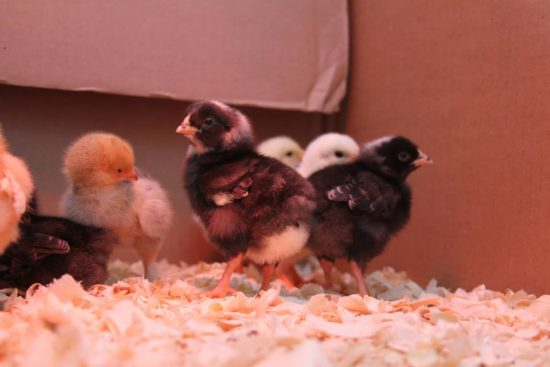
Raising chickens isn’t rocket science. But if you haven’t done it before, here’s what you need to get started:
- Cardboard box (how big depends on how many chicks you have)
- Pine chips
- Heat lamp
- Food (chick starter is available at Tractor Supply)
- Food dish
- Water dish
- Water
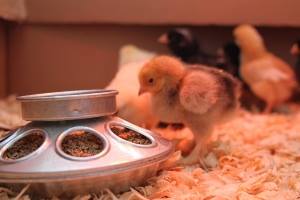
We weathered an indoor tiny rooster escape (he hung out under our piano feebly cockadoodling for about an hour before I could grab him and put him back in the box) and plenty of soggy pine chips, but, for the most part, once they were about six weeks old – and the weather was warm enough – we transitioned them out to their coop (bought off of craigslist from a local farmer). Since then, they have been pretty much maintenance free and even moved with us from Vermont to upstate New York this summer. While we left their digs behind, we’ve since converted a stall in our barn for the “girls” and they have adjusted easily to their new space.
And then there were ducks

Last spring, we were so over winter – so much so that during a routine Tractor Supply stop to pick up chicken feed and dog food, we ended up with a rather odd impulse purchase: three tiny ducklings. They were a spring preview, so to speak, because even though there was still snow on the ground, the fact that ducklings were available for $2.49 each meant that warmer weather was just around the corner.
We didn’t anticipate a few things with our impulse buy:
- Ducks grow faster than chickens. They quickly outgrew the medium-sized box we had for them and, soon, we had a refrigerator box in our living room.
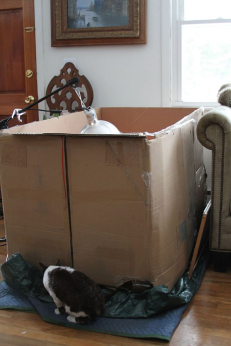
- Ducks are messy. Not only do they tip and spill water (so that we also had a tarp under the box in the living room), but they spent time in our bathtub, getting used to swimming. Cleanup afterwards was never a fun chore.
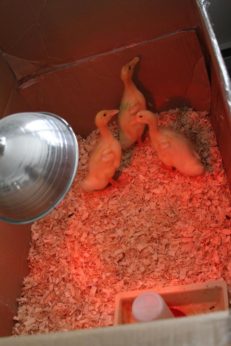
- Ducks are loud. Every night at 2 a.m. or so, they would start quacking. While we were thankful that our daughter managed to sleep through it, it drove my husband and me absolutely crazy.
After a few weeks, I was counting down the days to spring thaw and a duck coop. While coop design can range from geodesic dome to princess castle, we went with a basic do-it-yourself concept that primarily utilized pallet wood and ended up looking rather rustic chic.
Supplies:
- Pallets
- Foam insulation
- Lumber for door and additional framing of structure (including outside attached yard if building one)
- Plywood for roof and interior to cover insulation
- Roofing material
- Linoleum for floor (ducks are messy)
- Door hardware
- Chicken wire (for outside attached yard)
Tools:
- Sawzall reciprocating saw with bi-metal blade
- Hammer
- Nails
- Power screwdriver
- Pliers
- Staple gun
- Staples
Here’s what we did:
- Found a pallet big enough for the base. Because we only have three ducks, our coop didn’t need to be as big as the chicken coop.
- Stockpiled other pallets. We used a sawzall reciprocating saw to take them apart. This method made it not necessary to remove the nails – we just sawed through them.
- Next, we framed in the coop, angling the roof for easy snow removal. The roof was a single piece of plywood – the standard size from Home Depot ended up fitting perfectly without any extra sawing.

- With a pile of pallet wood already disassembled, we nailed the boards to the frame.
- On the interior, we lined the walls and ceiling with insulation before covering that with plywood.
- Once the structure was solid, we built simple doors: one big enough for us to get into the coop for cleaning and feeding and another smaller door on the other side to let the ducks in and out.
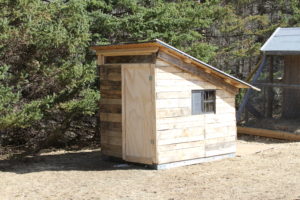
- Install thick linoleum floor to keep the place waterproof. Like I said above, ducks are messy. In fact, keep the water source out in the attached yard of the coop to minimize water inside.
- Framing in the outside yard was a matter of simply following the roof line and using some 2x4s and chicken wire.
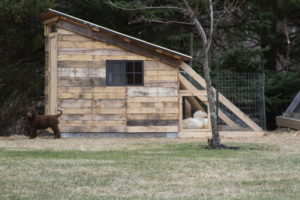
- The final step was lining the inside of the coop with pine chips and hanging the feeder in the corner.
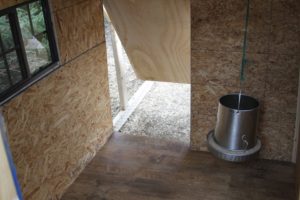
When it was time for the ducks to move out of my living room and into their coop, I’d been looking forward to it for a while. And I’d like to think that they were, too, considering how pleased they were with their new digs. That night, the silence in the house was absolutely priceless.


Kristen A. Schmitt writes about wildlife, sustainable agriculture, environmental issues and the outdoors. Her work has appeared in National Geographic, Fast Company, Audubon, Eating Well,USA Today, Hunt & Fish and others. Follow her @Kristen_Schmitt.
Five Things I Learned Going Rural
September 25th, 2016 by BTC Editor
Five things I learned going rural
By Kristen A. Schmitt
A few years ago, we moved away from the city, trekking 14 hours east of Detroit to the rural mountains of Vermont. My husband’s job brought us out that way and, while I was looking forward to the change, my previous life experiences didn’t really prepare me for the switch. I didn’t grow up camping, hiking, or hunting. In fact, my entire outdoors experience revolved around sidewalks, bicycles and complaining. Fast forward to 2016 and I not only spend at least 50% of my day outside (no matter the weather), but I’ve channeled my newfound enjoyment for the outdoors into writing for a variety of publications about bowhunting, archery, local food and backyard poultry, among other things.
The irony is that before our move, I wouldn’t have recommended going “rural” to anyone. And now? Not only did this move help me break free of my chain-link fence mentality, but it also gave me new knowledge and confidence that I bring to other areas of my life. So, in the tradition of Dave Letterman’s top ten lists, here’s the top five things I’ve learned since going rural:
5 ) Nature can be incredibly surprising.
Our property in Vermont was surrounded by forest, field and water. While we owned roughly 8 acres, the back of the property butted up to an 11-acre pond and the other sides were bordered by hardwood forest. It was more than just a switch from pavement to dirt roads. My nearest neighbors were bobcats (that tried to kill my chickens – twice), porcupines, peregrine falcons, eagles, and hawks; vultures, wild turkeys, juncos and herons. One particular incident involved a few nighttime visits from an ornery black bear interested in our trash.
We now have a 36-acre farm in upstate NY with a similar landscape.

4 ) Chickens are more than just tiny egg machines.
Being able to grab fresh eggs from your own chickens for breakfast is an unbelievable treat. Chickens are easier than any other type of livestock and mine did amazingly well in negative temperatures last winter. We’ve only lost one (to a bobcat); the others are hearty and healthy. As a writer, I work out of my house and have the ability to listen to the chicken “conversation” daily. I read somewhere that chickens have their own language and I can attest to that fact. Sitting on my porch with a mug of tea (or glass of wine, depending on the time of day) to watch them peck and chatter is one of my favorite activities.
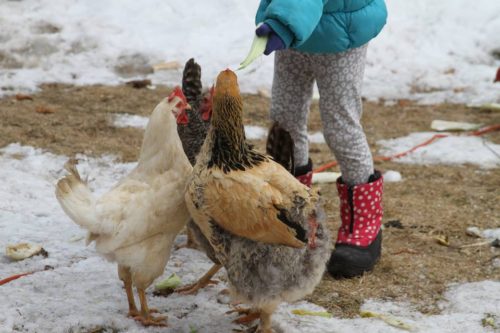
3 ) Eating vegetables that you grow yourself is an amazing experience.
My parents raised me well with a small backyard garden and fresh vegetables daily. But the significance of planting our own fruits and vegetables and maintaining our garden – especially one as large as we have – is priceless. Our young daughter seems way more connected to where her food comes from than I ever was until I became an adult. Picking that first piece of spinach or watching corn plump up on the stalks is exciting each and every time.
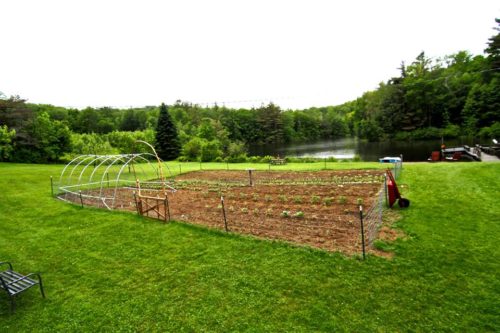
2 ) It takes a lot of wood to heat a house, especially with temperatures in the negatives for weeks. Prior to our move, we relied on city gas to heat our house in the suburbs like the majority of the country. Once we realized we could harvest our own heat from the forest on our property, we had a wood stove installed in the living room. Little did we realize that it takes a lot of wood to keep even a smaller house warm when the temperatures don’t go higher than -16 for weeks. Yet, if I had to do it again, I would. I like being able to see the physical amount of wood I used for heat rather than paying a faceless gas bill. Besides, splitting and stacking wood may not be a ton of fun, but it’s not bad. In fact, it warms you twice: once when you stack the wood; later, when you sit in front the fire.

1 ) I’m not helpless.
The main thing that I have learned from going “rural” is that I am not a helpless person. I am stronger than I’ve ever been and my passion and dedication to keeping up with this new lifestyle choice has me learning how to do new things every single day. If we hadn’t moved I wonder if I would feel this empowered in the physical aspects of life as well as the mental. This move has changed me for the better – and I can’t imagine ever living anywhere where I can’t see the stars.
Kristen A. Schmitt writes about wildlife, sustainable agriculture, environmental issues and the outdoors. Her work has appeared in National Geographic, Fast Company, Audubon, Eating Well,USA Today, Hunt & Fish and others. Follow her @Kristen_Schmitt.
